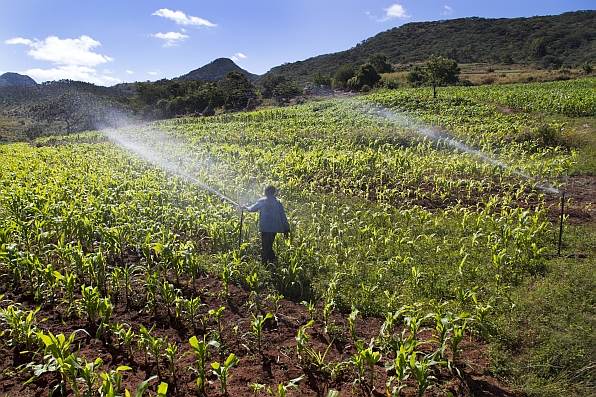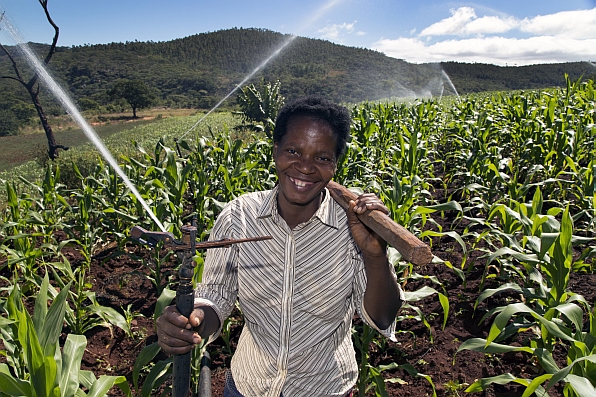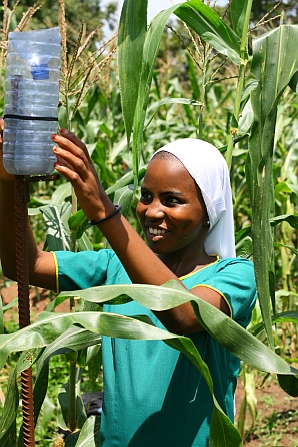Agricultural water productivity for sustainable development
Adoption of the United Nations Sustainable Development Goals (SDGs) has added new impetus to the far-reaching concept of agricultural water productivity. This is the idea that raising farm outputs or their value relative to the amount of water used in agriculture, by far the world’s biggest water consumer, is critical to address water scarcity.
SDG 6 (“ensure availability and sustainable management of water and sanitation for all”) includes a target (6.4) to “substantially increase water-use efficiency across all sectors.” For the first time, efficient water use has gained a prominent place on the international development agenda.

Bringing the idea to life
To help realize and track progress toward this target, researchers working with World Bank support have prepared a report that traces the theory and practice of improved water productivity in agriculture. They argue that future progress depends on making good use of past research.
Resulting from a study carried out by the Bank’s Water and Agriculture Global Practices, the new report (titled Beyond more crop per drop: Evolving thinking on agricultural water productivity) is a co-publication with the International Water Management Institute (IWMI). The authors describe the origins of the water productivity concept (chronicling its evolution in IWMI’s work over two decades), the development of methods to measure it, efforts to put the concept to use through applied research and lessons learned.

They trace the origins of IWMI’s research on water productivity to a 1996 IWMI research report, which aspired to usher in a “new era of water resources management.” The report argued that conventional notions of “efficiency” may not be appropriate for water management and planning at the basin scale, as they do not take into account the potential reuse of water. The report suggested instead that the Institute should go beyond its previous focus on “irrigation efficiency” wider hydrological systems, especially river basins.
Guided by this new thinking, the Institute brought the water productivity concept to life, helping build strategies to improve water management in key river basins across the developing world. The concept was at the heart of a series of major initiatives, whose work continues through the CGIAR Research Program on Water, Land and Ecosystems (WLE), now entering its second phase.
Beyond crop per drop

In the course of these initiatives, researchers conducted numerous case studies, covering efforts to improve water productivity from farmers’ fields to whole watersheds across Africa, the Americas and Asia. This work resulted in more than 300 journal articles, reports and other documents, representing a wealth of knowledge about pathways toward increased water productivity and about the tangible contributions of these gains to development objectives, especially stronger food security, reduced rural poverty, and improved natural resource management.
As this work unfolded, researchers were keenly aware of the need to get the numbers right. To this end, they developed an approach called “water accounting,” which made it possible to estimate with reasonable accuracy how water is used and re-used for diverse purposes at different levels in river basins and to identify opportunities for “real” water savings.
In assessing the costs and benefits of these savings, researchers went beyond the “crop per drop” slogan, recognizing the broader implications of increased water productivity and the need for other indicators to gauge progress towards diverse development objectives. Recent developments in the water accounting approach have enabled users to assess not only water flows, fluxes, stocks and consumption in river basins but also the potential impacts of different water management strategies on agriculture and ecosystem services.
Toward a more nuanced approach
From this experience, the World Bank/IWMI report derives a set of lessons learned that open the way toward a more nuanced approach for applying the water productivity concept to deliver on the SDGs. Here is a brief summary:
- Be precise. Productivity and efficiency concepts require clear definition when applied to complex problems in water management.
- Scale and context matter. Efficiency gains from water-saving technologies do not necessarily lead to proportionate reductions in water use.
- Know your objectives. Maximizing water productivity should not be the goal itself but rather one of many indicators that help understand crop production and farmers’ decisions in diverse contexts.
- Beware of unintended consequences. When examining the contributions of water productivity to broader development objectives, take into account not only the overall benefits but also their distribution as well as the trade-offs between objectives.
- Be mindful of conceptual limitations: Agricultural water productivity focuses on one factor in a multi-factor and multi-output production process. Reliance on a single factor can mask the complexity of agricultural systems as well as the tradeoffs required to achieve desired outcomes.
- Use new technologies, and promote cross-disciplinary approaches. Developments in water accounting and approaches from related disciplines provide new insights and opportunities for better defining, assessing and analyzing agricultural water productivity and efficiency.
These words of water wisdom are the report’s main takeaways for researchers and development planners. The overall message is that research on agricultural water productivity has focused attention on water scarcity and helped create a strategic opportunity to address not only how SDG 6 is interpreted but other development goals and investments that strive for efficient, equitable and sustainable water management.
Read the report
Giordano, M.; Turral, H.; Scheierling, S. M.; Tréguer, D. O.; McCornick, P. G. 2017. Beyond “more crop per drop”: Evolving thinking on agricultural water productivity. Colombo, Sri Lanka: International Water Management Institute (IWMI); Washington, DC, USA: The World Bank. 53p. (IWMI Research Report 169). [doi: 10.5337/2017.202.]

